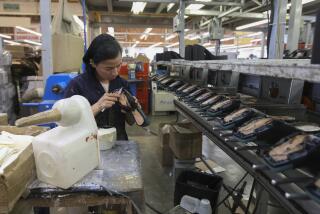Poor Harvests Force China to Buy Huge Amounts of U.S. Wheat
WASHINGTON — China is buying huge supplies of American wheat this year to help make up for its own disappointing grain harvest, and U.S. experts say that it now appears China may become the leading food importer in the world over the next decade.
The large grain purchases are considered surprising because only four years ago, China was virtually self-sufficient in food production. Since then, U.S. experts say, the low sums that China has invested in agriculture and the low prices paid to peasants for grain have caused output to stagnate.
For U.S. grain companies and farmers, China’s massive purchases this year mean roughly $1 billion of income. Yet, for American taxpayers, the sales to China actually could cost $100 million or more. Under a program launched in 1985, the U.S. government subsidizes the sale of grain overseas to help American exporters match or undercut their foreign competition.
Figures Not Released
China has not made public this fall’s harvest figures, and U.S. grain companies say they have been sworn to secrecy by Chinese officials about the amounts of wheat being bought. But officials at the U.S. Agriculture Department estimate that China will buy more than 7 million tons of American wheat this year and another 8 million tons from other countries.
“The Chinese are back into the world market in a big way,” one department official said.
Its 1988 imports will make China the third-largest grain importer in the world, after Japan and the Soviet Union. By current projections, China will surpass those two countries in the mid-1990s.
“The food prospect for China is of special concern, not merely because it is the world’s largest food consumer but because its planners may be greatly overestimating its future gains in food production,” the Worldwatch Institute, a private U.S. research group that keeps track of world food and environmental trends, reported this fall.
Major Economic Problem
For China itself, U.S. analysts say, the inability to increase food production has become a major economic problem, one that could contribute to inflation and cause a drain on the national budget.
“I think they are at a turning point,” said Nicholas R. Lardy, an American specialist on Chinese agriculture at the University of Washington. “The value of China’s agricultural output has been dropping every year since 1984. If they continue these imports, we’re talking about a huge amount of money they will have to spend.”
The Chinese leadership is now acknowledging the severity of the problem. “Agricultural stagnation cannot be allowed to continue,” the Chinese Communist Party newspaper People’s Daily said a month ago.
After Chinese leader Deng Xiaoping came to power a decade ago, he abolished the communes established by Mao Tse-tung and allowed peasants to cultivate their own plots of land. For five years, grain output shot up to the point where, in 1984, China harvested 407 million tons of grain, the largest amount in its history.
Harvest Estimates
It has never been able to reach that level again. According to Agriculture Department estimates, this year’s harvest in China will be about 400 million tons. Its population, meanwhile, continues to grow at the rate of about 1.4% per year. “China’s agricultural miracle is over,” one U.S. analyst said.
“Up to the early 1980s, the Chinese were astounded at how rapidly food output had increased,” Lardy said. “It has taken four years of disappointments for them to realize that the reforms of the early 1980s are not a long-term solution. They have not been willing to put in the investment they need.”
According to Lardy, the share of national investment that China spends on agriculture--for irrigation facilities, rural transportation, fertilizers and fuel--is now the lowest it has been since the Communist takeover in 1949.
Another factor reducing China’s grain output has been that peasants have been seeking to convert rice and wheat fields to other purposes, such as cash crops or rural industries, that will bring in more money.
Lester R. Brown, director of the Worldwatch Institute, said that China now seems to be following the path of its more prosperous Asian neighbors--Japan, Taiwan and South Korea. In these countries, a high rate of industrialization has caused land and workers to be shifted out of agriculture--and grain production has declined.
Last year, China imported about 5.4 million tons of American wheat, according to Agriculture Department officials. In 1985 and 1986, China had imported virtually no American grain and, in fact, exported more grain onto the world market than it imported.
By current department estimates, China will import at least 15 million tons of grain this year, including 7 million tons of wheat from the United States. That wheat now earns about $150 to $160 per ton for U.S. exporters.
In 1985, at the behest of American farm groups, the Agriculture Department launched a new Export Enhancement Program, which was designed to lower the price of American grain overseas. Under the program, the U.S. government pays subsidies to American exporters to make up the difference between world prices and the higher prices for grain inside the United States.
Over the last two years, the Agriculture Department has allowed China to buy more than 10 million tons of American wheat under the subsidy program. The only country getting larger amounts of subsidized grain under the program has been the Soviet Union.
More to Read
Sign up for Essential California
The most important California stories and recommendations in your inbox every morning.
You may occasionally receive promotional content from the Los Angeles Times.










